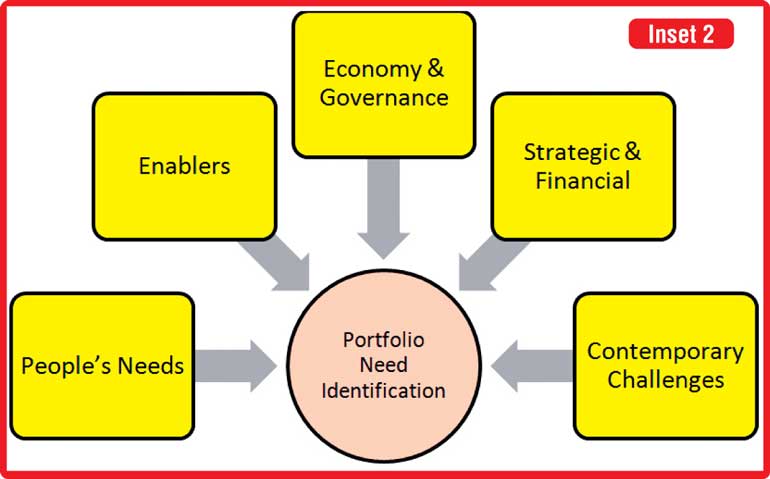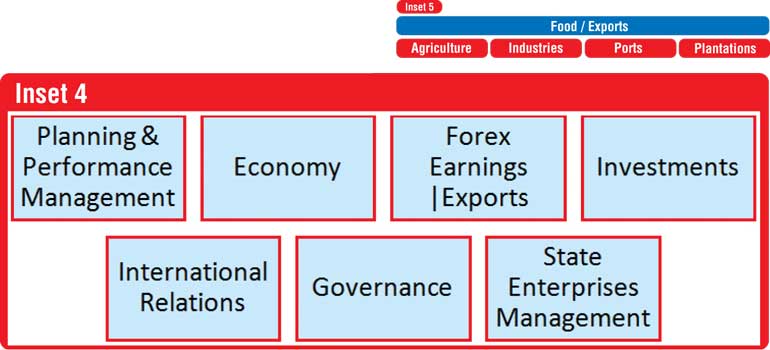MTI Consulting, over the last 18 years, have worked on organisational re-structuring projects across diverse public and private organisations in over 40 countries. In this feature, MTI applies their research, learnings and expertise to propose a ‘Ground Zero’ approach to re-structure the Sri Lankan Cabinet.

Why apply a ‘Ground Zero’ model to the Sri Lankan Cabinet?
-
The effectiveness of a Government is significantly determined by the way it is structured, starting with the scoping and segmentation of the ministries – because all other government institutions are structured based on this ‘super structure’.
-
Governments tend to carry on with historical structures, with incremental portfolios added as and when the need arises e.g. technology, disaster management, national integration etc. or combining un-related portfolios (see inset 1)
-
There has also been a tendency to create a plethora of micro focused responsibilities e.g. wild life, botanical gardens, private transportation
The net result of all these is a cluttered portfolio of ministries that lack focus. The installation of a new government is an ideal opportunity to go completely ground-zero and develop the ministerial portfolios based on the strategic needs of the country. Such a process could then lead to rationalising and re-structuring / re-scoping the large number of state institutions that operate within the ministries

Step 1: Go completely ‘Ground Zero’ – which means assume none of the current ministerial portfolios exist and avoid any reference to any current ministerial names, even later on in the process (see inset 2).
Step 2: Apply ‘People’s Need’ as the first basis of structuring
-
Why? Governments exist only to serve / meet the needs of people. Therefore, in structuring the government, it should be based on the specific needs of the people
-
How? Starting with basic human needs, hierarchically exploring all types of physical, physiological, social, safety and economic needs
If the above is applied to the Government of Sri Lanka, the first-cut based on people’s needs will be as shown in inset 3.

Step 3: Identifying the ‘Economy and Governance’ based Ministerial Needs
-
Why? Beyond the people’s needs, at a macro level the government needs to manage the economy and ensure effective governance (including the effective management of all other ministries) – this then leads to the need for other ministries.
-
How? In order to ensure and manage all portfolios identified (applying multiple criteria), what types of economic management and governance functions needs to be undertaken? Accordingly the ‘first-cut’ list has been identified as shown in inset 4.

Step 4: Strategic & Financial implication for Ministerial Portfolio
-
Why? In identifying the ministries based on the ‘People’s Needs’ and ‘Economy and Governance’, there is tendency for wide variation in the scope and scale of the ministries identified and therefore some key functions may not get adequate focus.
-
How? Estimating the strategic and financial value of the portfolios (identified under each of the other modules) and then deciding which ones require further segmentation.
Step 5: Contemporary National Challenges – that demand ministerial focus
-
Why? The world we live in today confronts us with dynamic socio-economic and political challenges, which governments need to respond and in some cases there needs to be institutions to manage/respond to these challenges
-
How? Evaluate all the current/emerging socio-economic and political challenges that the country encounters and decide if any of these warrant a dedicated portfolio
Accordingly, for Sri Lanka the following have been identified:
National Integration
Disaster Management

Step 6: Ministries that are needed for the ‘Enabling’ role
-
Why? When identifying the ministries based on the criteria under Steps 2 to 5, the focus is on the front-end needs, consequently the enabling ministries (also known as back office or shared services functions) do not get captured.
-
How? For each of the ministries identified thus far, examine the need for the enabler role, based on what has been identified in inset 5.
Step 7: Rationalise the 36 Ministerial Needs that were identified by applying the 5 structuring criteria
Applying the 5 different criteria, we have arrived at 36 portfolios of varying scopes. While this is exhaustive, there is the possibility of over-laps and more importantly the need to rationalise and merge some of the portfolios – in the pursuit of ensuring a max of 15 Cluster Ministries (considered an optimal number).

Step 8: Arriving at the final list of 16 ‘Cluster Ministries’- by applying the following structuring principles:
-
Strategic synergies – where more than one portfolio can be merged for strategic and link reasons
-
Specialisation and Separation – where portfolios need to be kept very distinct – despite not justifying sufficient ‘workload’ and responsibility to match the other portfolios
-
Use of contemporary terms that reflect the above and the ‘end-user’ expectations
See inset 6
Structuring considerations in arriving at the above
-
Law and Order will also be responsible ‘crime prevention’
-
Public Welfare is a cluster of public services, social welfare, national integration, religious practices and disaster management
-
Enterprise Development has been added to Industrial Development – so that the former focuses on the SMEs, while the latter focuses on large scale industrial infrastructure development, including the vital logistics component
-
International Relations (currently known as the foreign ministry) will also have responsibility for ‘International Investments’ (FDIs) – because when have such an extensive network of foreign missions, why only use this for diplomatic and consular work? Hold them responsible for investment targets.
-
Financial Services will be part of Economy, Planning and Governance
-
State Enterprise Development can either fall under the relevant line ministry or under ‘Economy, Planning and Governance’ (which in any case will be responsible for the Governance of these SOEs)
-
Tea and Rubber Plantation, by virtue of being largely for exports, will fall under Export Earnings, while the other could be under ‘Food and Agriculture’
-
National Fitness aims to develop a fit and healthy nation – given its positive impact on national productivity

Step 9: Each of the ‘Cluster Ministries’ are then further segmented into ‘Sector Ministries’ – using the same structuring principles as above (see inset 7).
Step 10: Set KRAs and KPIs – each Minister’s performance appraisal to be presented to both the parliament and the public. Then, apply the process down to the next level of Government Departments and SOEs.






